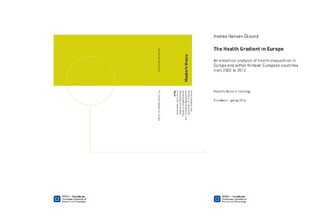| dc.description.abstract | During the last three decades there has been a growing research interest on socioeconomic health inequalities, but where most of the studies have been on individual health determinants. The aim of this paper will be to look at the contextual determinants of health since they often affect individual determinants. Studies done on health inequalities show that there are inequalities between different social groups no matter how these groups are divided (by education, social class, income, etc.), and that these inequalities are apparent in every country and society in Europe.
This thesis will look at the trends in social health inequalities between 2002 and 2012 in Europe and within thirteen European countries. Three potential contextual explanations were presented; the financial crisis, welfare state regimes and Wilkinson’s income inequality hypothesis. Self-reported health is here the health indicator, while education is used as the indicator of socioeconomic position. Unemployment rates and the Gini-index are the two contextual variables used. The analyses are conducted through OLS-regression and multilevel modeling. The individual data used are collected from the European Social Survey, module 1 through 6, while the contextual variables are collected from the World Development Indicators, Pordata and Eurostat.
Two main findings were drawn from the results. The first is the persistency in inequalities in self-reported health in Europe as well as within most of the European countries during these ten years. The persistency, as well as the stability seen in most countries, can possibly be explained by the time it might take for changes in unemployment rates and the Gini-index to show significant results on health inequalities. This result might also be due to the small changes in the Gini-index, causing insignificant change in the distribution of power, relative deprivation and psychosocial stress, just as proposed by the income inequality hypothesis. The hypothesis is however having a hard time explaining the persistency in health inequalities between countries and welfare state regimes since the welfare states with the smallest income inequalities are not the ones with the smallest health inequalities. The stability in health inequalities in nine of the thirteen countries might also be explained by the welfare state regimes these countries belong to and the welfare benefits they have. According to the second finding the Netherlands and Spain have increasing health inequalities in 2010 and 2008 respectively, while Portugal and Slovenia have decreasing health inequalities in 2006 and 2008. For all four countries alterations in unemployment rates might explain these significant changes to some degree, even though they all seem to have different underlying factors having an effect (economy and welfare benefits i.e.). | nb_NO |
